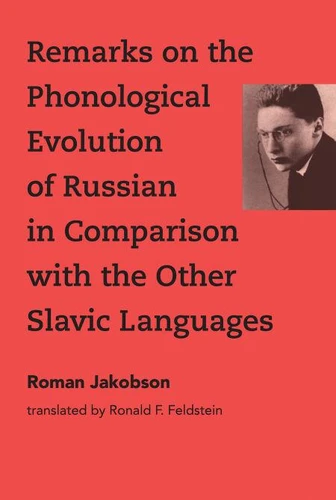Remarks on the Phonological Evolution of Russian in Comparison with the Other Slavic Languages
Par : ,Formats :
Disponible dans votre compte client Decitre ou Furet du Nord dès validation de votre commande. Le format ePub protégé est :
- Compatible avec une lecture sur My Vivlio (smartphone, tablette, ordinateur)
- Compatible avec une lecture sur liseuses Vivlio
- Pour les liseuses autres que Vivlio, vous devez utiliser le logiciel Adobe Digital Edition. Non compatible avec la lecture sur les liseuses Kindle, Remarkable et Sony
- Non compatible avec un achat hors France métropolitaine
 , qui est-ce ?
, qui est-ce ?Notre partenaire de plateforme de lecture numérique où vous retrouverez l'ensemble de vos ebooks gratuitement
Pour en savoir plus sur nos ebooks, consultez notre aide en ligne ici
- Nombre de pages240
- FormatePub
- ISBN978-0-262-34884-3
- EAN9780262348843
- Date de parution20/11/2018
- Protection num.Adobe DRM
- Taille4 Mo
- Infos supplémentairesepub
- ÉditeurThe MIT Press
Résumé
The first English translation of a classic and groundbreaking work in historical phonology. This is the first English translation of a groundbreaking 1929 work in historical phonology by the renowned linguist Roman Jakobson, considered the founder of modern structural linguistics. A revolutionary treatment of Russian and Slavic linguistics, the book introduced a new type of historical linguistics that focused on the systematic reasons behind phonological change.
Rather than treating such changes as haphazard, Jakobson here presents a "teleological, " purposeful approach to language evolution. He concludes by placing his book in the context of the exciting structural developments of the era, including Einstein's theories, Cezanne's art, and Lev Berg's nomogenesis. The original Russian version of the book was lost during the 1939 German invasion of Brno, Czechoslovakia, and the only edition available until now has been the French translation by Louis Brun.
Thus this first English translation offers many linguists their first opportunity to read a major early work of Jakobson. Ronald Feldstein, a leading Slavicist and phonologist in his own right, has not only translated the text from French to English, he has also worked to reconstruct something as close to the missing original as possible. Feldstein's end-of-chapter annotations provide explanatory context for particularly difficult passages.
Rather than treating such changes as haphazard, Jakobson here presents a "teleological, " purposeful approach to language evolution. He concludes by placing his book in the context of the exciting structural developments of the era, including Einstein's theories, Cezanne's art, and Lev Berg's nomogenesis. The original Russian version of the book was lost during the 1939 German invasion of Brno, Czechoslovakia, and the only edition available until now has been the French translation by Louis Brun.
Thus this first English translation offers many linguists their first opportunity to read a major early work of Jakobson. Ronald Feldstein, a leading Slavicist and phonologist in his own right, has not only translated the text from French to English, he has also worked to reconstruct something as close to the missing original as possible. Feldstein's end-of-chapter annotations provide explanatory context for particularly difficult passages.
The first English translation of a classic and groundbreaking work in historical phonology. This is the first English translation of a groundbreaking 1929 work in historical phonology by the renowned linguist Roman Jakobson, considered the founder of modern structural linguistics. A revolutionary treatment of Russian and Slavic linguistics, the book introduced a new type of historical linguistics that focused on the systematic reasons behind phonological change.
Rather than treating such changes as haphazard, Jakobson here presents a "teleological, " purposeful approach to language evolution. He concludes by placing his book in the context of the exciting structural developments of the era, including Einstein's theories, Cezanne's art, and Lev Berg's nomogenesis. The original Russian version of the book was lost during the 1939 German invasion of Brno, Czechoslovakia, and the only edition available until now has been the French translation by Louis Brun.
Thus this first English translation offers many linguists their first opportunity to read a major early work of Jakobson. Ronald Feldstein, a leading Slavicist and phonologist in his own right, has not only translated the text from French to English, he has also worked to reconstruct something as close to the missing original as possible. Feldstein's end-of-chapter annotations provide explanatory context for particularly difficult passages.
Rather than treating such changes as haphazard, Jakobson here presents a "teleological, " purposeful approach to language evolution. He concludes by placing his book in the context of the exciting structural developments of the era, including Einstein's theories, Cezanne's art, and Lev Berg's nomogenesis. The original Russian version of the book was lost during the 1939 German invasion of Brno, Czechoslovakia, and the only edition available until now has been the French translation by Louis Brun.
Thus this first English translation offers many linguists their first opportunity to read a major early work of Jakobson. Ronald Feldstein, a leading Slavicist and phonologist in his own right, has not only translated the text from French to English, he has also worked to reconstruct something as close to the missing original as possible. Feldstein's end-of-chapter annotations provide explanatory context for particularly difficult passages.














